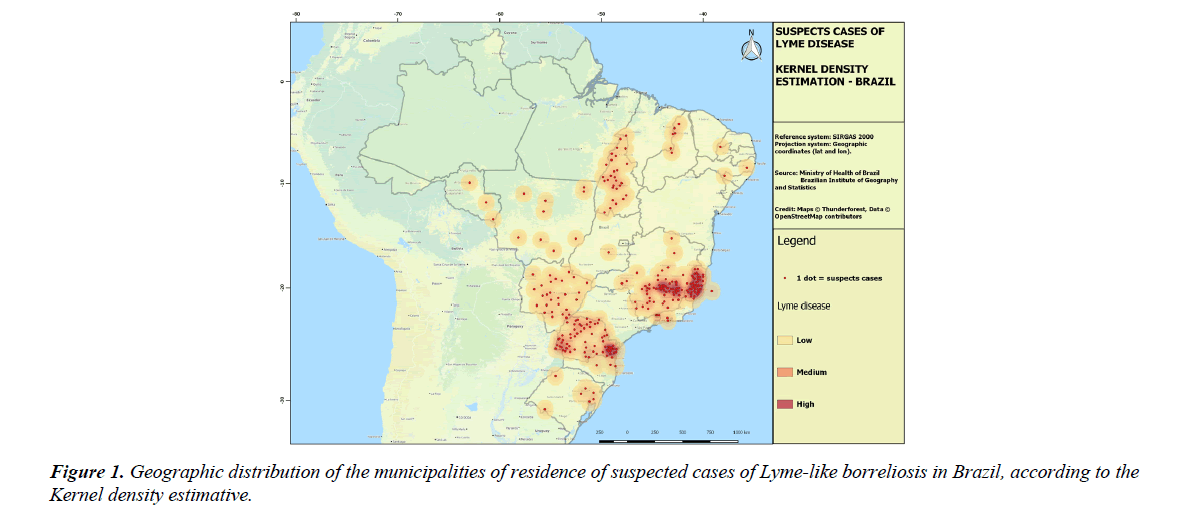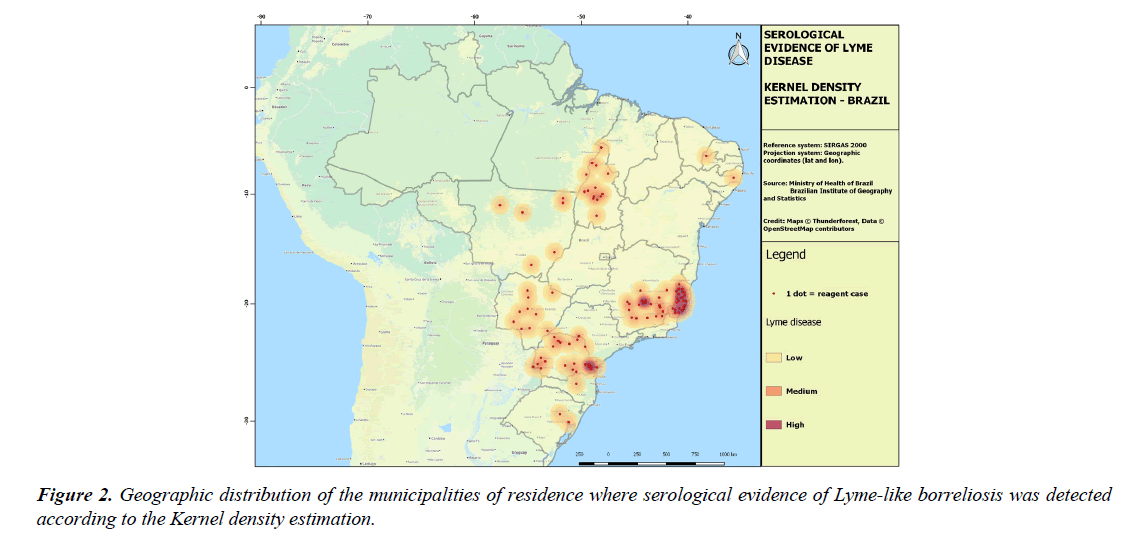Letter to Editor - Journal of Parasitic Diseases: Diagnosis and Therapy (2017) Volume 2, Issue 1
Geographical distribution of Lyme-like borreliosis in Brazil: Hot spots for research and surveillance.
Stefan Vilges de Oliveira1,2*, Kerollen Hawane Carneiro de Oliveira1, Janduhy Pereira dos Santos3 and Gilberto Salles Gazeta2
1Health Surveillance, Secretariat of the Ministry of Health, Brasília, Distrito Federal, Brazil
2National Reference Laboratory for Rickettsial Disease Vectors of the Oswaldo Cruz Foundation, Rio de Janeiro, Brazil
3Department of Geography, University of Brasília, Distrito Federal, Brazil
- *Corresponding Author:
- Stefan Vilges de Oliveira
Health Surveillance Secretariat of the Ministry of Health Brazil
Tel: +55 (61) 3213-8232
Mobile: +55 (61) 98105-3118
E-mail: stefanbio@yahoo.com.br
Accepted date: April 06, 2017
Citation: de Oliveira SV, de Oliveira KHC, dos Santos JP, et al. Geographical distribution of Lyme-like borreliosis in Brazil: Hot spots for research and surveillance. J Parasit Dis Diagn Ther. 2017:2(1):12-13
Dear Editor,
Clinical cases of Lyme borreliosis in Brazil have been diagnosed since 1992 [1].
From studies that have accompanied cases of this disease in the country it’s possible to identify that epidemiological, clinical, and laboratories aspects are different from cases of Lyme disease recorded in the United States and Eurasia, the Brazilian Lyme borreliosis has been called Lyme-lyke disease or Syndrome Baggio-Yoshinari [2].
The etiological agent causer of this disease has not yet been detected (isolation and molecular characterization) in human samples from the cases described in the country [2] and a portion of the medical and scientific community questions the occurrence of the disease in the Brazilian territory.
In order to increase the knowledge about Lyme-like borreliosis in Brazil, we analyzed the records included in the Gerenciador de Ambiente Laboratorial (GAL), which is the information system that collects the data on the requests for laboratory diagnostic tests in the scope of the Brazilian Health System.
During the years 2009 to 2016, 4078 laboratory tests for Lyme-like borreliosis were requested in 5.02% (280-5570) of the Brazilian municipalities (Figure 1).
Of these, 679 laboratory tests were reactive in the Federated Units (FU) of Espírito Santo 31.95% (217-679), Paraná 23.12% (157-679), Tocantins 17.52% (119-679), Mato Grosso do Sul 14.58% (99-679), Minas Gerais 8.24% (56-679), Mato Grosso 3.82% (26-679), Pará 0.14% (1-679), Rio Grande do Sul 0.14% (1-679), Santa Catarina 0.14% (1-679) and 0.29% did not respond to the residence FU (2-279) (Figure 2).
Reactive cases were detected by Western blotting tests (67.89%) and enzyme immunoassay 32.10% (218-679) in 1.92% (107- 5570) of the Brazilian municipalities.
We analyzed the geographical groupings of municipalities with suspect cases (Figure 1) and with reagents laboratory tests (Figure 2) by Kernel's density estimative. We found spatial interpolation with greater intensity in the states of Paraná, Minas Gerais, Espírito Santo and Tocantins (Figures 1 and 2).
Analyzing the information about the patients which occurred the clinical suspicions, it was verified that the majority of the cases reacted with male 62.59% (425-679), aged between 21 to 60 years 68.36% (466-679), residents of the urban area 42.70% (290-679). The quality of epidemiological information (profile of suspected cases) may be hampered by the fact that the GAL does not have this attribution as the main purpose. The GAL is a laboratory information system and is not intended to collect epidemiological information.
Lyme-like borreliosis is not a notifiable disease to the Brazilian Ministry of Health and official information is restricted to laboratory data and some states in Brazil do not include this information in the GAL.
We understand that the data presented here are preliminary to any assessment of the magnitude of the disease. We will not discuss the efficiency of the serological results, since in Brazil there are no official definitions on validated diagnostic methodologies for characterization of cases.
Our information draws attention to the need for research interventions and epidemiological surveillance in the areas where the disease hot spots were included.
It is estimated that in the United States of America 300,000 cases of Lyme borreliosis infections occur annually and 85,000 in Europe, demonstrating the magnitude of this important tick-borne disease in other parts of the world [3-5].
In Brazil, government investments could promote a better qualification of these clinical suspicions and consequently improvement of epidemiological information, helping to understand the cases of Lyme-like borreliosis.
References
- Yoshinari NH, Barros PJL, Cruz FCl, et al. Clínica e sorologia da doença de Lyme no Brasil. Rev Bras Reumatol. 1992;32:57.
- Yoshinari NH, Mantovani E, Nazario BVL, et al. Doença de Lyme-símile Brasileira ou Síndrome Baggio Yoshinari: Zoonose exótica e emergente transmitida por carrapatos. Rev Assoc Med Bras. 2010;56:363-9.
- Stanek G, Wormser GP, Gray J, et al. Lyme borreliosis. Lancet. 2012;379:461-73.
- Lindgren E, Jaenson TGT. Lyme borreliosis in Europe. Influences of climate and climate change, epidemiology, ecology and adaptation measures. Copenhagen, Denmark: World Health Organization. 2006.
- Pritt BS, Mead PS, Johnson DK, et al. Identification of a novel pathogenic Borrelia species causing Lyme borreliosis with unusually high spirochaetaemia: a descriptive study. Lancet Infect Dis. 2016;16:556-64.

